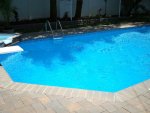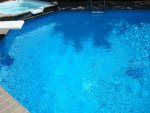Hey all,
First I want to say that I really respect and appreciate all the knowledgable people on this site. You guys have all helped me out tremendously whenever I have any problems. Most of the time I don't even need to post a question since its already been posted and answered 10 times before
That all being said:
I do not use the BBB method for my pool at all. I have a 16' x 38' IGP / Vinyl with a DE filter. I use a chlorinator with pucks and 1 or 2 bags of Cal Hypo shock about every other week for maintenance.
I test the pool every week for chlorine and PH, but only with a very cheap test kit with strips you dip into the pool.
The pool is always sparkling perfect.
I have no idea what the CYA is, what the CH is, what the CC is, etc. But the pool is unbelievably perfect as far as the way it looks.
This method requires me to do nothing other than test once a week, add pucks every other week, and throw a bag or two of shock in every once in a while.
So is there really a good reason to switch to the BBB method? It seems like SO much more work!
Because I get so much information out of this board, this year I almost made the switch. But I got nervous because for 5 years my pool quality (or at least visually anyway) has been perfect.
Im worried that if I switch, I will have to maintain it daily and perhaps not have as good results as I have now.
So I am asking all the pool geniuses here if I should switch???
It has been 5 years... At some point is my CYA (which I have never tested) going to be too high for the chlorine to be effective? Or will I have to much CH because of the Cal Hypo?
Thanks in advance.
First I want to say that I really respect and appreciate all the knowledgable people on this site. You guys have all helped me out tremendously whenever I have any problems. Most of the time I don't even need to post a question since its already been posted and answered 10 times before

That all being said:
I do not use the BBB method for my pool at all. I have a 16' x 38' IGP / Vinyl with a DE filter. I use a chlorinator with pucks and 1 or 2 bags of Cal Hypo shock about every other week for maintenance.
I test the pool every week for chlorine and PH, but only with a very cheap test kit with strips you dip into the pool.
The pool is always sparkling perfect.
I have no idea what the CYA is, what the CH is, what the CC is, etc. But the pool is unbelievably perfect as far as the way it looks.
This method requires me to do nothing other than test once a week, add pucks every other week, and throw a bag or two of shock in every once in a while.
So is there really a good reason to switch to the BBB method? It seems like SO much more work!
Because I get so much information out of this board, this year I almost made the switch. But I got nervous because for 5 years my pool quality (or at least visually anyway) has been perfect.
Im worried that if I switch, I will have to maintain it daily and perhaps not have as good results as I have now.
So I am asking all the pool geniuses here if I should switch???
It has been 5 years... At some point is my CYA (which I have never tested) going to be too high for the chlorine to be effective? Or will I have to much CH because of the Cal Hypo?
Thanks in advance.




